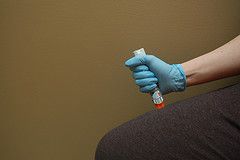What Your Pharmacist Can't Tell You About Drug Expiration Dates: 'It's Complicated'

One of the most common questions people ask health care providers is, Can I use my old drugs past their expiration dates?
The short, safe answer is a simple “no.” However the truth of the matter is much more intricate, a lot more interesting, and requires a bit of knowledge about the Food and Drug Administration (FDA).
In the late 1970s, the FDA first began requiring expiration dates on both prescription and over-the-counter medications.
“To assure that a drug product meets applicable standards of identity, strength, quality, and purity at the time of use, it shall bear an expiration date determined by appropriate stability testing,” reads the agency’s regulation. The FDA permits “reasonable variation,” meaning manufacturers are given a little leeway, so long as the any medication marketed in the United States contain between 90 percent to 110 percent of the amount of the active ingredient claimed on the label.
“Just having the slight variation of 90 to 110 percent, well, it would be very difficult, from a manufacturing standpoint, to hone it down even more than that,” Dr. Lee Cantrell, of the California Poison Control System and UC San Francisco School of Pharmacy, told Medical Daily.
The legal code adopted by the FDA also notes that manufacturers must account for storage conditions (and reconstitution conditions for certain drugs) in the expiration date. As a result of FDA rules, then, you will find a date, usually following the letters ‘EXP,’ either printed on the label or stamped onto the bottle or carton of drugs you buy, and in other cases, crimped into the tube of certain ointments you purchase.
The expiration date of most medicines is 12 to 60 months after manufacture, reports Pharmacy Times. According to Pittsburgh-Post Gazette, pharmacists further shorten the time a medicine can be used when they add their own "discard after" or "beyond-use" date to the prescription label itself. From manufacturer to FDA to pharmacist, the underlying principle is maximum safety.
And, to underscore its own message, the FDA made a brief video a few years back:
Seems like the end of the story, at least from the FDA’s perspective. However, if you are looking for an intelligent rebuttal of expiration dates, the best place to turn is to the very same alphabet soup government agency, the FDA.
Stockpiled Drugs
In the mid-1980s, as described by an article appearing in Biosecurity and Bioterrorism, the Air Force approached the FDA about “the possibility of safely extending the expiration dates of some of the drugs that it had stockpiled.” The Department of Defense routinely stockpiles medications for future use by both the military and civilians. This expensive process includes costs for planning, proper storage, and also reeplacing expired drugs. Since the latter cost eats up a significant portion of the Air Force budget, the Shelf Life Extension Program (SLEP) was proposed and undertaken by the FDA in 1985 to determine the actual shelf life of stockpiled drugs. In short, SLEP was born to save taxpayer dollars.
In its inaugural 1985 run, the program tested 56 drugs and found it was possible to extend the shelflife of 80 percent of them (and 84 percent of the tested lots) by as much as three years. With lots of dollars saved, the program naturally didn’t end there. An update of SLEP in 2006 investigated stability profiles for 122 different drug products (slightly more than 3,000 different lots) and resulted in a lifespan extension of at least one year beyond the original expiration date for 88 percent of the lots. The average additional time added to each drug was 66 months.
Among the drugs tested and approved for continued use were two antibiotics, amoxicillin (commonly prescribed to children) and ciprofloxacin (commonly called 'cipro' and used to treat anthrax infections), an antihistamine (diphenhydramine, often used to treat allergies), and a morphine sulfate injection (a painkiller).

Certainly, the FDA has provided comprehensive information suggesting required expiration dates may not be as firm as most consumers suppose, and this is substantiated by the work of others. In 2009, The Medical Letter, an independent nonprofit that provides unbiased drug-prescribing recommendations to professionals, reviewed the most recent data on the same subject. Importantly, the publication addresses safety first.
The authors found just one report of a patient who may have been harmed by taking an expired drug. This singular case, involving a patient who may have suffered kidney damage after taking expired tetracycline (an antibiotic), occurred more than 40 years ago. (Since that era, tetracycline products have been reformulated.)
Noting storage in heat and high humidity may shorten a drug’s half-life, The Medical Letter report also acknowledges that in many published studies a variety of medications stored under “stress” conditions remained chemically and physically stable for up to nine years beyond their expiration dates. Generally, the authors warn, liquid drugs are not as stable as solid dosages, and should a liquid become cloudy, discolored, or show signs of precipitation, it should not be used.
“Many drugs stored under reasonable conditions in their original unopened containers retain 90 percent of their potency for at least 5 years after the expiration date on the label, and sometimes much longer,” The Medical Letter report concludes, with one important caveat: “Epinephrine in EpiPen is an important exception” as these products gradually lose potency once the expiration date passes.

Cantrell and his colleagues travel an inspired path to scientific gold, arriving at a similar conclusion for their 2012 study.
In his wanderings, Cantrell “stumbled across” a box of drugs, all of which had expired 28 to 40 years prior. Unearthed in a family-owned pharmacy generations old, the box contained drugs which had remained in their original, unopened containers for decades. In “the name of science,” Cantrell and friends undertook analysis of the drugs.
In the lab, tablets were dissolved, isotopes diluted, chromatography tests run. Three times, the science crew tested and retested samples for listed active ingredients. What did they discover?
Of the 14 drugs, 12 (or 86 percent) were present in concentrations at least 90 percent of the labeled amounts, which is the generally recognized minimum acceptable potency. Surprisingly, three of these compounds were present at greater than 110 percent of the labeled content. The team found two compounds (aspirin and amphetamine) in amounts of less than 90 percent; meanwhile, another ingredient (phenacetin) appeared at greater than 90 percent in one drug but less than 90 percent in another.
“Given the potential cost-savings, we suggest the current practices of drug expiration dating be reconsidered,” Cantrell and his co-authors wrote in the conclusion.
Speaking with Medical Daily, Cantrell advised caution.
“My study didn’t convey anything about safety, I just looked at potency of active ingredients,” he said. Though an active ingredient may be as strong as the manufacturer originally intended, this does not mean the overall drug — a chemical jamboree, essentially — remains non-toxic, he explained. In fact, no scientific study has ever tested expired medications in human subjects and so he does not advocate using drugs past their due dates.
“I myself wouldn’t feel comfortable taking an outdated antibiotic, if you’re trying to kill a potentially life-threatening bug invading my system,” he said.



























